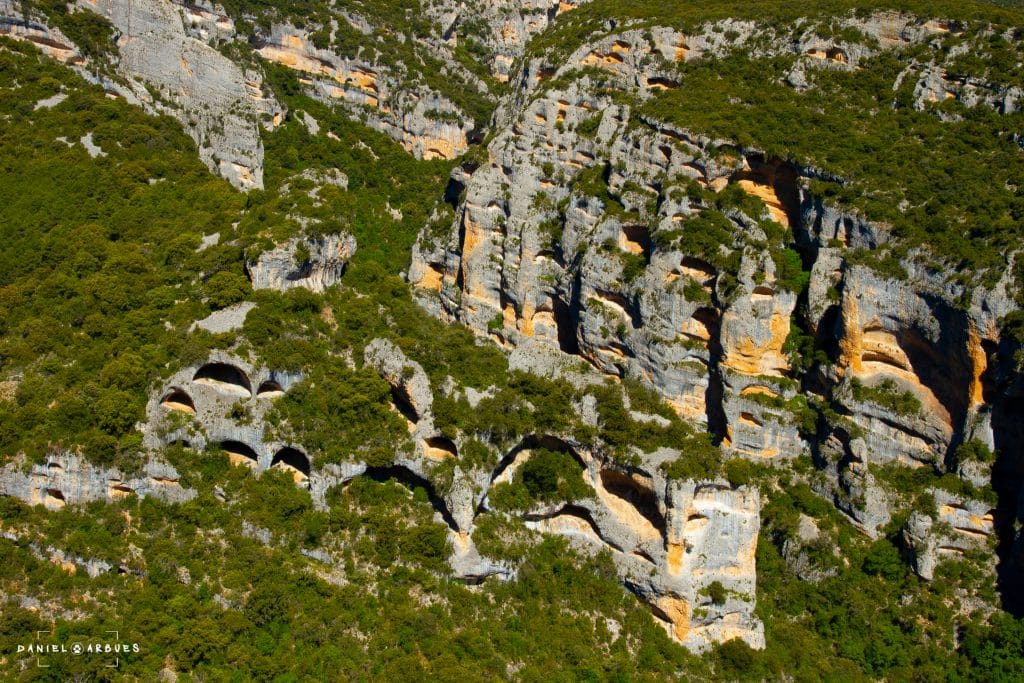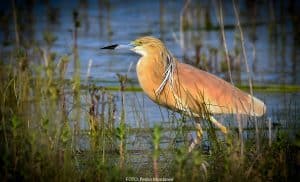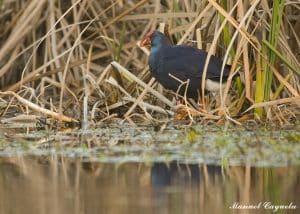Experience Wildlife
- North Spain
ARAGON GRAND BIRDING TOUR
- Description
ARAGON
If we had to choose one word to summarise our region, it would be “diversity“. The fact that Aragon occupies the central part of the Ebro Valley, ranging from the French border to the Iberian system, means plenty of environments can be enjoyed within just a 100 km range.
The landscape changes drastically in short lengths, ranging from 3,000 meters high peaks in the Pyrenees to the arid to semi-desert lowlands of the Ebro river basin or more Mediterranean-like ecosystems as we move towards the Iberian chain down south.
The Birding Aragon itineraries consist of a series of organised trips designed by and for birdwatching enthusiasts. All the accommodation and guides involved in the trip belong to the Birding Aragon Association and share a passion and respect for nature that all experienced birdwatchers require during an observation trip.
The proposed journey manages to comfortably cover the most representative areas of our region. Each of them is strikingly singular in terms of nature…

STEPPES AND WETLANDS OF THE EBRO BASIN
The central part of Aragon, known as the Ebro Basin, has very peculiar geographical and climatic characteristics. It is made up of large flat areas at low altitudes above sea level, and has low rainfall, a prevalence of dry winds and significant temperature contrasts between winter and summer.

Visited Areas: Gallocanta Lagoon Nature Reserve, Belchite and El Planeron reserve of steppe birds, Los Monegros dessert and Bardenas Reales.
CENTRAL PYRENEES
Exuberant and conspicuous, the alpine peaks and vast extensions of woodland give way to the unique geological formations found in the lower plains making this landscape one of the most geographically varied and abundantly bio-diverse natural reserves. Large areas of this region are protected as a result of the great variety of species which are rare or even absent from the rest of Europe.

Areas Visited: Sierra y Cañones de Guara Natural Park, Ordesa and Monte Perdido National Park, Posets-Maladeta Natural park, Los Mallos de Riglos Natural monument.
- Route
The tour price includes the transport from/to Zaragoza airport and Zaragoza Delicias Train Station with a dedicated driver. Besides the excellent rail connexions of Zaragoza with Barcelona and Madrid, Ryanair operates flights between Zaragoza and London, among many other European cities on a regular basis.
- Itinerary
Reception at Zaragoza airport and train station followed by a 1h 20′ private transfer to our first accommodation at Gallocanta lagoon. A presentation is given by Birding Aragon on the next days’ trips, followed (flight-times allowing) by some free time to check out the area before dinner.

Gallocanta is a natural paradise for bird and nature observers. At an altitude of more than 1,000 metres above sea level, it is one of the main salty wetland areas in western Europe. Gallocanta lagoon serves as an important migration stopover point in the Western Palearctic Ecozone on the Common Crane migration routes, and during the time of permanent water levels in winter, it is also possible to see some of the largest populations of Ferruginous Duck and Red-Crested Pochard in Spain.

Recently, the reedbeds of the lagoon have been declared of international importance due to the presence of a population of one of the most endangered small birds in Europe: the Aquatic Warbler. The second-largest colony of Great Bustards can also be found near the lagoon.
Habitats: Arable plains, steppes with natural vegetation, gallery forests, Mediterranean shrubland, lagoons and reservoirs, limestone cliffs.

| 
| 
|
Special Interest Species: Black Stork, Black Kite, Egyptian Vulture, Short-Toed Eagle, Northern Harrier, Montagu’s Harrier, Golden Eagle, Lesser Kestrel, Peregrine Falcon, Little Bustard, Great Bustard, Eurasian Stone-Curlew, Black-Bellied Sandgrouse, Dupont’s Lark.
Lecera and Belchite represent exceptional examples of steppe areas. Forty thousand hectares of steppe landscape, including the 645-hectare El Planerón nature reserve, make this the best habitat of its kind in northern Spain.

This windswept, arid land of dusty, red, scrub-covered plains and eroded plateaux, more reminiscent of Morocco or Afghanistan than western Europe, holds large percentages of the Spanish populations of pin-tailed sandgrouse, black-bellied sandgrouse, lesser short-toed lark and the elusive and enigmatic Dupont’s lark. In terms of heritage, the remains of the old town of Belchite are one of the most striking vestiges of the 1936 – 1939 Civil War in Spain.
Habitats: The best-preserved steppe vegetation in the Ebro Valley, plains with arable fields and river cliffs.

| 
| 
|
Special Interest Species: Black Kite, Egyptian Vulture, Short-Toed Eagle, Northern Harrier, Montagu’s Harrier, Golden Eagle, Lesser Kestrel, Peregrine Falcon, Little Bustard, Great Bustard, Eurasian Stone-Curlew, Black-Bellied Sandgrouse, Pin-Tailed Sandgrouse, Eurasian Eagle-Owl, Dupont’s Lark, Common Redstart, Whinchat, Common Rock Thrush, Dartford Warbler, Subalpine Warbler, Wood Warbler, European Pied Flycatcher, Southern Grey Shrike.
On the way north through the largest steppe desert in Europe, we will visit some key wildlife areas including Sastago and Sariñena Lagoons, which play an essential role as a resting and feeding area for over 100,000 birds during annual migrations.

Further north, the spectacular environment of the Sierra de Guara range is revealed in the fantastic landscapes sculpted by water erosion. Its famous canyons are narrow and deep ravines where rivers, whose waters have a striking turquoise colour, meander forming impressive waterfalls, siphons and caves. The steep rocky walls are exceptional places for large birds such as the Griffon Vulture, the Golden Eagle or the Bearded Vulture to establish their nests. It is also possible to see wild boar, fox, wildcat, doormouse and pine marten.
Habitats: Arable crop plains, natural steppes, riparian forests, pine forests and Mediterranean scrub, paddy fields, lagoons and reservoirs, mosaics of rainfed and holm oak crops, forest and Mediterranean scrub, rock faces.

| 
| 
|
Special Interest Species: Common Shelduck, Grey Partridge, Squacco Heron, Black Stork, European Honey Buzzard, Bearded Vulture, Egyptian Vulture, Short-Toed Eagle, Montagu’s Harrier, Golden Eagle, Booted Eagle, Bonelli’s Eagle, Lesser Kestrel, Peregrine Falcon, Baillon’s Crake, Eurasian Stone-Curlew, Eurasian Eagle-Owl, Common Rock Thrush, Blue Rock Thrush, Dartford Warbler, Subalpine Warbler, Bearded Reedling, Eurasian Penduline Tit, Red-Backed Shrike, Hawfinch.
From the 3,000 metre summits to the lower mountain ranges that connect with the plains, we can find a number of birds of great interest. In the next two days, we focus on exploring two of the most representative protected areas of the Pyrenees and, without a shadow of doubt, some of the best places in the world to observe the majestic Bearded Vulture along with Griffon and Egyptian Vultures in their natural habitat, the National Park of Ordesa and Monte Perdido, and Natural Park of Posets-Maladeta.

A highly diverse fauna shelters within this massive natural area. Marmots, easy to detect by their sharp whistles, wild boar and chamois are the largest and easiest mammals to observe, but it ia also a great habitat for Pyrenean newts and vipers.
Habitats: Mixed and Coniferous forests, mountain pastures, limestone cliffs and peaks.

| 
| 
|
Special Interest Species: Rock Ptarmigan, Western Capercaillie, Grey Partridge, Bearded Vulture, Egyptian Vulture, Short-Toed Eagle, Golden Eagle, Booted Eagle, Eurasian Woodcock, Alpine Swift, Alpine Accentor, Common Rock Thrush, Ring Ouzel, Wallcreeper, Eurasian Treecreeper, Ed-Backed Shrike, Alpine Chough, Wwhite-Winged Snowfinch, Citril Finch.
Our next destination will bring us to the foot of The Natural Park of the Western Valleys located in the northwest corner of the Aragonese Pyrenees. Our stay in the small village of Berdun offers the perfect starting point for our next soutward journey.

Los Mallos de Riglos Natural Monument will be the next highlight on our way. These massive, ochre limestone conglomerates, rising to 300 metres in height, serve as protection for birds of prey who nest and breed in the many hollows and crevasses.
Habitats: Atlantic forests, mountain pastures, limestone cliffs and summits, a mosaic of rainfed and holm oak crops, forest and Mediterranean scrub and rock cuts.

| 
| 
|
Special Interest Species: Rock Ptarmigan, Western Capercaillie, Grey Partridge, European Honey Buzzard, Bearded Vulture, Egyptian Vulture, Short-Toed Eagle, Northern Harrier, Golden Eagle, Booted Eagle, Bonelli’s Eagle, Peregrine Falcon, Eurasian Eagle-Owl, Alpine Swift, Alpine Accentor, Aommon Rock Thrush, Blue Rock Thrush, Ring Ouzel, Dartford Warbler, Subalpine Warbler, Wallcreeper, Red-Backed Shrike, White-Winged Snowfinch, Citril Finch, Hawfinch.
Throughout the last day of our route south to Zaragoza, we will be surrounded by the Bardenas Reales badlands where the soils of clay, chalk and sandstone have been eroded by the elements, creating surprising shapes, canyons, plateaus, tabular structures and isolated hills. The fauna and flora in this UNESCO Biosphere Reserve are more typical of the African continent than of northern Iberia.

Habitats: Paddy fields, reedbeds, lagoons and reservoirs, pine forests and scrubland

| 
|
Special Interest Species: Common Shelduck, Eurasian Bittern, Little Bittern, Squacco Heron, Black Stork, European Honey Buzzard, Northern Harrier, Bearded Reedling, Eurasian Penduline Tit.
After a relaxed breakfast at our accommodation in Zaragoza, it’s time to make our way home. If return schedules allow, there will be time for one last walk along the Ebro riverbanks in the morning. Zaragoza airport and train station transfer will be provided if required.
- Accommodation
Aragon is known for its picturesque countryside and charming rural areas. The rural guesthouses and country hotels participating provide in a regular basis accommodations for visitors interested in birding. These accommodations offer a peaceful and immersive experience, often located in scenic locations surrounded by nature. You can expect amenities such as comfortable rooms, home-cooked meals, and local insights into birding hotspots.
A full list of the selected accommodations for this trip can be found in our brochure. Please don’t hesitate to download it and request us any further info you might need.



- What's included:
- Accommodation in a double room with a private bathroom for single or double use.
- All meals included. Lunches are prepared in-house to be taken away during the walks as picnics when needed.
- Transportation and transfers from and to the origin (Zaragoza airport and train station)
- English-speaking local support guides.
- Entry tickets to all the attractions visited.
- Welcome pack: Cloth bag, bento picnic box and a refillable aluminium bottle.
- What's not included
- International flights
- Travel insurance
- Last day dinner in Zaragoza
- Additional drinks, tips, and any other personal expenses
- Comments
Book or enquire
"*" indicates required fields













